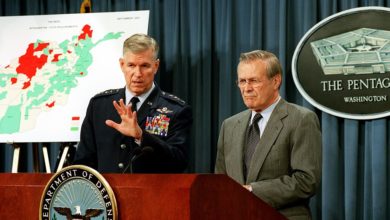
What unites and what divides the Democrats and Republicans with regard to Iraq?
The fierce resistance to the colonial occupation of that country has opened fissures at the top of the U.S. political establishment over the past year, bringing calls from many leading politicians, including Democratic presidential candidate John Kerry, for “internationalizing” the occupation—asking other countries to provide military and economic support for the U.S.-colonial rule of Iraq.
Kerry is emphatically not calling for an end to the occupation. In fact, he and a number of other leading Democrats insist that more U.S. troops must be sent to Iraq and that the U.S. military in general is too small to carry out its “global mission.”
At present there are around 140,000 U.S. troops in Iraq, along with 25,000 soldiers from other countries and thousands of “private security” mercenary forces. Massive numbers and superior firepower notwithstanding, the occupiers have not been able to suppress or contain the Iraqi resistance, which by all accounts has grown not only in size but in strategic and tactical sophistication.
The failure of the U.S. occupiers to defeat the resistance, the growing death toll and the enormous cost of the war has shocked the political establishment of this country. Kerry and the Democrats are critical of the Bush Administration for not giving more of an international cover to the occupation, which they believe would open the way for bringing in tens of thousands of additional troops from Europe, India, Pakistan and elsewhere.
What there is no disagreement about among the ruling elite—whether Republican or Democrat—is the need to hold onto Iraq as part of a strategy of domination of the entire oil-rich and strategic Middle East. Control of the region has been a central objective of U.S. international policy for six decades. Domination of the area is a foundation stone of the National Security Strategy (NSS-USA) adopted as the official doctrine of U.S. foreign policy in September 2002.
Iraq and the roots of the “national security strategy”
Although the NSS-USA is perceived by many as a creation of latter day neo-conservatives, its roots are bi-partisan and extend back to World War II. In the latter stages of that war, the Roosevelt and Truman administrations, dominated by big banking, oil and other corporate interests, were determined to restructure the post-war world to ensure the dominant position of the United States.
The key elements in their strategy were: first, U.S. military superiority in nuclear and conventional weaponry; second, U.S. domination of newly-created international institutions like the United Nations, International Monetary Fund and World Bank, and the establishment of the dollar as the world currency; and third, control of global resources, particularly oil.
In pursuit of the third key element, the United States was intent on taking hold of certain strategic assets of the British Empire, regardless of their wartime alliance. Among those assets was Iraq.
A February 1944 exchange between Franklin Roosevelt and British Prime Minister Winston Churchill makes clear that the British were well aware of U.S. intentions. Churchill wrote Roosevelt: “Thank you very much for your assurances about no sheep’s eyes [looking enviously] on our oilfields in Iran and Iraq. Let me reciprocate by giving you the fullest assurance that we have no thought of trying to horn in upon your interests or property in Saudi Arabia.” (quoted in Gabriel Kolko, The Politics of War, New York, 1968)
What this note showed was that the U.S. designs on Iran and Iraq, both key neo-colonies of Britain, had set off alarm bells in British ruling circles.
Both Roosevelt and Truman were Democrats. Roosevelt is viewed as an almost mythological figure by many Democrats today. Yet, it was in Roosevelt’s last term in office (1942-45) that the foundation of what is today known as the National Security Strategy was laid down.
What restrained the full implementation of that strategy for nearly a half-century was a wave of anti-colonial revolutions and the emergence of the socialist camp in Europe and Asia after World War II.
Despite Churchill’s blustery objections to U.S. designs on their crumbling empire, there was nothing the British could do to restrain rising U.S. power. Within a few years, the British ruling class would adapt to the new reality and accept its role as Washington’s junior partner, a role in which it continues up to the present.
In 1947, the “Truman Doctrine” proclaimed that the U.S. would act to prevent revolution in Greece and Turkey, the western wing of the Middle East. In the process, the U.S. pushed aside the British, the traditional dominant power in Greece.
Under Republican President Eisenhower in 1953, a CIA coup overthrew the nationalist government of Prime Minister Mossadegh, and put the Shah, Iran’s feudal king, back on the throne. With that coup, the U.S. displaced Britain as the dominant power in Iran.
By the mid-1950s, the U.S. was moving in on Iraq as well. In 1955, Washington set up the Baghdad Pact based in Iraq’s capital. The pact included the pro-western regimes in Pakistan, Iran, Turkey and Iraq, along with Britain.
The Baghdad Pact had two purposes: opposing the rise of Arab and other liberation movements in the Middle East and south Asia, and completing the anti-communist encirclement of the socialist camp
Washington’s obstacle: the Iraqi masses
On July 14, 1958, a military rebellion in Iraq led by Brigadier Abdul Karim Qasem and the Free Officers movement turned into a country-wide revolution. The revolution put an end to colonial domination and marked the beginning of Iraq’s real independence.
Although the Iraqi Communist Party was the biggest organized force among the revolutionary forces, the revolution did not lead to a socialist transformation of the country. The ICP strategy was alliance with the anti-colonial nationalist bourgeoisie, with the ICP in the subordinate role.
Though not a socialist revolution, the Iraqi Revolution created panic in Washington and on Wall Street. Eisenhower called it “the gravest crisis since the Korean War.”
The day after the Iraqi Revolution, in keeping with the counter-revolutionary “Eisenhower Doctrine,” 20,000 U.S. Marines began landing in Lebanon. The day after that, 6,600 British paratroopers were dropped into Jordan. Had they not, the popular impulse from Iraq would have surely brought down the Western-dependent regimes in Beirut and Amman.
But Eisenhower and his generals had something else in mind as well: invading Iraq, overturning the revolution and re-installing a puppet government in Baghdad.
Washington was forced to abandon that plan. The sweeping character of the Iraqi Revolution, combined with the announcement by the United Arab Republic (now the two states of Syria and Egypt) that its forces would fight the imperialists if they invaded Iraq, meant the conflict would not be confined to Iraq. The People’s Republic of China and the Soviet Union also strongly backed the Iraqi revolution, with the USSR mobilizing troops in the southern Soviet republics close to Iraq.
The combination of these factors forced the U.S. leaders to accept the existence of the Iraqi Revolution. But Washington never really reconciled itself to the loss of Iraq.

Bipartisan goal: dominate the Middle East
Over the next three decades, the United States applied many tactics designed to weaken and undermine Iraq as an independent country.
Washington supported the more rightist elements within the post-revolution political structure against the communist and left-nationalist forces. For example, the Kennedy administration backed the overthrow and assassination of President Qasem in 1963 by a right-wing Iraqi coup.
According to the late King Hussein of Jordan, who was himself on the CIA payroll for many years, U.S. intelligence services provided the names of communists and other progressives to the new military government. Thousands were tortured and killed, a blow from which the Iraqi Communists never fully recovered.
At various times—for instance after Iraq completed nationalizing the Iraqi Petroleum Company in 1972 and signed a defense treaty with the USSR—the United States, under the Republican Nixon, gave massive military support to Kurdish elements fighting Baghdad. It later added Iraq to its list of “terrorist states.”
Nixon’s Democratic opponent that year, the liberal George McGovern, said that Vietnam was “the wrong war, in the wrong place, at the wrong time.” That reflected the worries of a sector of the U.S. ruling class that the U.S. was so bogged down in southeast Asia that it couldn’t take on a new war in the far more strategic Middle East.
Nixon’s answer was his own doctrine. The “Nixon Doctrine” based U.S. military supremacy on the double pivots of Israel and Iran, both of which were now receiving massive military aid from the U.S.
The Democratic Carter administration applauded the new suppression of the ICP and unions by the Ba’athist government in the late 1970’s. And after the Iranian Revolution of 1979 demolished the Nixon Doctrine, the “Carter Doctrine” established the Rapid Deployment Forces and signaled the beginning of a massive build-up of U.S. forces based in the Gulf region.
From 1980-88, during both the Democratic Carter and Republican Reagan administrations, the United States encouraged and helped to fund and arm Iraq, under the leadership of Saddam Hussein, in its war against Iran. At the same time, the U.S. provided Iran with anti-aircraft missiles, a fact revealed due to the “Iran-Contra” scandal.
Secretary of State Henry Kissinger revealed the real U.S. ruling class attitude about the war: “I hope they kill each other.”
Counterrevolution in the USSR and the Gulf War
Shortly after the Iran-Iraq war ended in 1988, the Gorbachev leadership in Moscow sharply cut back its support for allies in the developing world. This was the beginning of a new phase for U.S. policy in the Middle East.
In 1989, Gorbachev withdrew support for the socialist governments in Eastern Europe, most of which then collapsed. This sharp shift in the world relationship of forces, culminating with the destruction of the Soviet Union itself two years later, opened the door for the U.S. war against Iraq in 1991.
It would have been inconceivable even a few years earlier that Soviet leaders would have stood by while the United States sent more than a half-million troops to attack a nearby country with which the USSR had a mutual defense agreement.
The first Bush administration imposed a total blockade on Iraq through the United Nations Security Council only four days after Iraq invaded Kuwait, following a long and heated dispute between the two countries. Utilizing the pretext of “defense of Kuwait,” Bush immediately dispatched 550,000 U.S. troops to the Middle East.
After “Operation Desert Storm” in 1991 and the deliberate destruction of most of Iraq’s civilian infrastructure, the sanctions-blockade was kept in place. The monthly death toll among Iraqi civilians, especially children under the age of five, soared into the thousands due to the lack of clean water and adequate food and medicine.
Clinton and Bush continued the war
The blockade and its massive death toll continued under the Clinton administration, as did the bombing of Iraq. Asked in May 1996 on CBS’s “Sixty Minutes” if the death toll of more than a half-million Iraqi children was “worth the price,” Madeleine Albright, then U.S. ambassador to the U.N. and later Clinton’s Secretary of State, replied: “This is a hard decision for us, but yes, we think the price is worth it.”
The next month, the CIA puppet group “Iraqi National Accord,” headed by the current appointed “prime minister” of Iraq, Iyad Allawi, and spies within the UN weapons inspection teams, attempted a coup in Iraq, which was quickly crushed.
In 1998, Clinton eagerly signed the “Iraq Liberation Act,” which made “regime change” the official policy of the U.S. with regard to Iraq.
Some in the progressive movement claim that Clinton’s murderous policy toward Iraq was due to “right-wing pressure” or “concessions to the right.” This reflects a misunderstanding of the true character of the Democrats and their co-equal role in the imperialist system.
Under the first and second Bush regimes and the Clinton regime, the genocidal sanctions, bombing, and “weapons inspections” were elements of a strategy intended to weaken and ultimately eliminate Iraq’s ability to exist as an independent country.
Having achieved its 60-year quest to take control of Iraq, no U.S. administration, Democrat or Republican, is about to voluntarily give it up. Iraq, after all, holds the second largest oil reserves in the world. Military domination of global petroleum resources is a key element in the struggle for global hegemony as envisioned in the NSS-USA.
As hated as the Bush Administration and its program has become, hopes that Kerry’s global policies will be qualitatively “better” can only be sustained by disregarding the history of the past 60 years.
Just as in Vietnam, imperialist war and occupation in Iraq will not be ended in the polling booth. That task will be achieved by the popular resistance of the Iraqi people and the global anti-war and anti-imperialist movement.
Ancient mosque in Karbala, Iraq.
Photo: Bill Hackwell
Over half a million Iraqi children died as a direct result of U.S. sponsored sanctions.
Photo: Bill Hackwell






